Stay calm. It’s the most vital thing to remember when you find yourself in your vehicle, and the engine refuses to turn on.
Need tools for your project? Toolbox, a tool rental marketplace, might be worth a look.
If you’re thinking of how to jumpstart your car, don’t overthink this problem. When it comes to mechanical issues of this sort, you can work them out through a process of elimination. There are 3 common causes of a car’s engine not starting properly:
- Dead battery
- Faulty starter
- Failed alternator
Even people with no mechanical experience can identify the problem under their car’s hood with a little detective work, and get their car’s engine running once again.
Bad battery vs. bad starter vs. bad alternator?
Your car’s electrical system is complex, confusing, and sometimes frustrating to understand. Should your vehicle not want to start or start properly, we will help you figure out whether this problem is caused by a bad battery, faulty starter, or failed alternator. Troubleshooting this – like in most things electrically-powered in our lives today – requires a system of logic to solve the problem.
| CAUSE | SYMPTOM | SOLUTION |
|---|---|---|
| Bad Battery | Engine won’t crank over and makes clicking noises when trying to start the vehicle | Recharge the battery |
| The engine requires numerous starts before engine cranks over | Check battery terminals for loose connections; replace if the battery is aged | |
| The engine requires frequent jump starts | Replace the battery | |
| No lights, no clicking noises when starting the vehicle | Jumpstarting is needed as the battery is dead; battery may require replacement | |
| Bad Starter | Grinding noises when attempting to start the engine | Starter motor needs repair/replacement |
| Whirring noises when starting vehicle but engine won’t crank over | Starter motor needs replacement | |
| Vehicle’s dashboard lights are on but the engine won’t turn over | Starter motor needs repair/replacement | |
| Bad Alternator | Flickering or dimming headlights while the engine is running | Alternator needs repair/replacement |
| The engine dies immediately after jump-starting | Alternator needs repair/replacement | |
| Dashboard light appears with “ALT” or battery icon | Alternator needs repair/replacement |
Bad battery
Begin your fault-finding mission with the most common culprit causing a car to not start: the battery. Like all auto parts, those components have a lifespan of just a few years. And they take a tremendous amount of beating day-in and day-out.
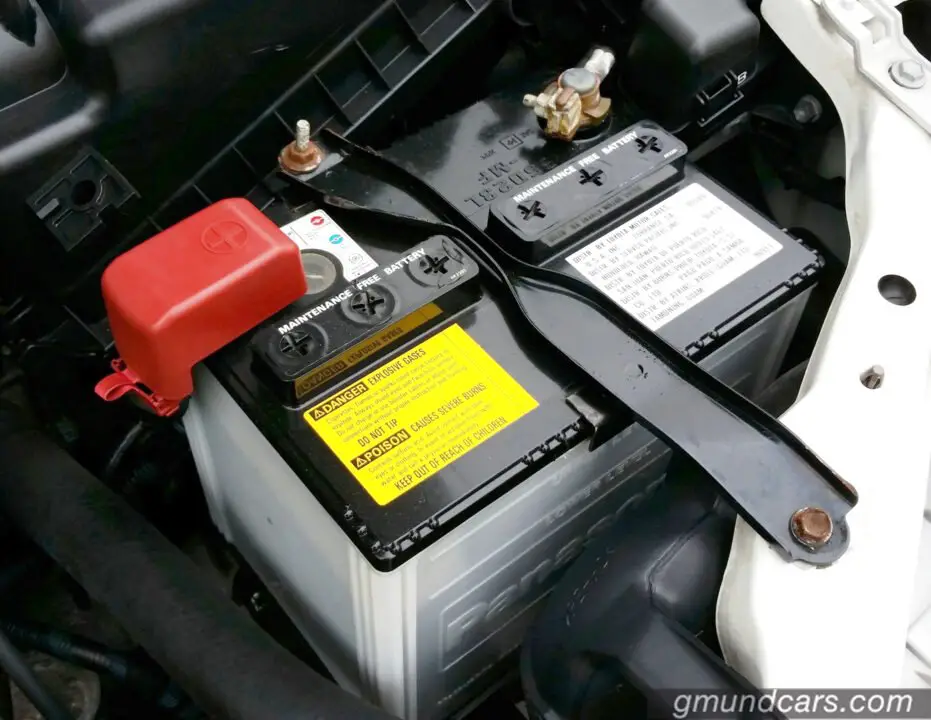
Unfortunately, a bad battery could leave you stranded at the side of the road at any time. However, you will notice bad battery symptoms. If your engine requires numerous starts before the engine eventually cranks over, it is a signal for you to inspect your battery’s terminals for any loose connections. These connections are held in place with a simple bolt. Sometimes they work loose over time and can cause starting problems for your car.
When you turn the key in the ignition, is all you hear from under the hood just clicking noises? It means your battery can’t keep a charge anymore. And you’ll need to jumpstart it to get the engine running again. This sign is the most prominent symptom of a failing car battery, leading to more frequent jumpstarts until one day, it will not respond.
If you turn the key in your car’s ignition and the engine doesn’t crank over, no dashboard instruments or gauges light up. And the only way to start your vehicle is by jumpstarting it. Sadly, this is a sure sign that your vehicle’s battery is completely dead.
Bad starter
Grinding and whirring noises from under the hood when you try to start the engine is definitely a bad starter symptom. Sometimes the engine will crank over after a few moments, but those noises will be all you’ll eventually hear when you expect your engine to start.
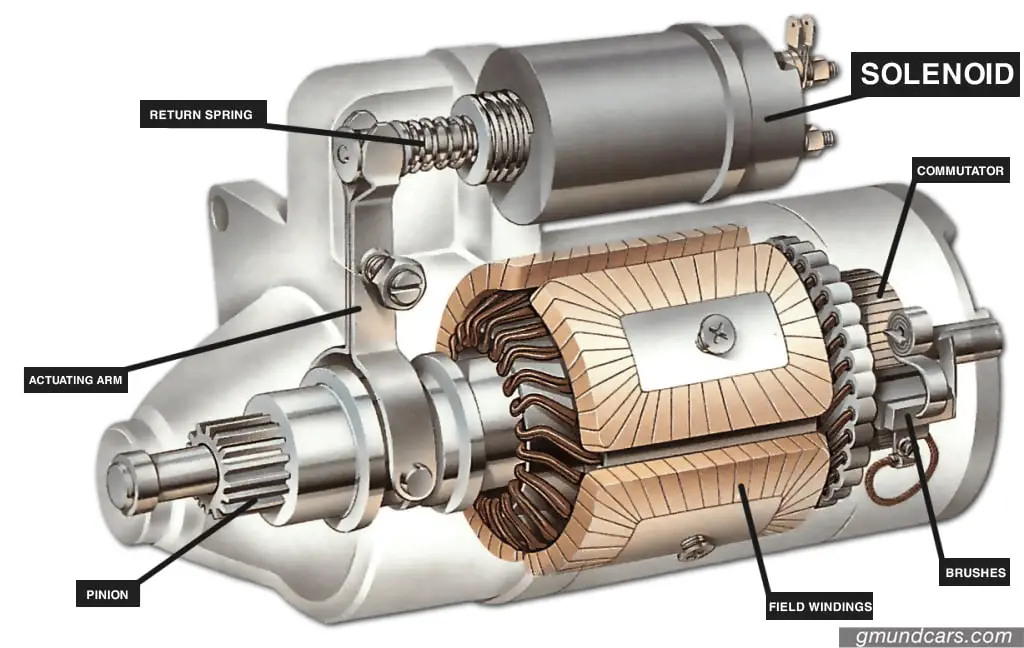
What are the other symptoms to know about a faulty alternator? When you attempt to start the motor, but only the car’s dashboard lights come on while the engine remains dead. You don’t need to bother looking any further: you need to repair or replace your car’s starter.
Bad alternator
Of the three most common problems that cause cars’ starting problems, a bad alternator should be the last factor to inspect. Do your car’s headlights dim or flicker as soon as you start the engine? Or, if you have just jumpstarted your vehicle, does the engine die as soon as you unplug the jumper cables? If you’ve answered yes to either of those questions, your alternator can’t keep your vehicle’s battery charged. And you need to repair or replace it as soon as possible.

Some newer cars will also display a battery-shaped warning light or “ALT” on your dashboard when you crank the engine over. Use that signal as your warning to head straight to your nearest trusted auto shop to repair or replace your vehicle’s alternator.
Read more: Bad alternator: Signs to tell and what to do? »
How to jumpstart a dead battery with a portable jump starter
A portable jump starter is the most uncomplicated and straightforward way to jumpstart your car’s engine. You don’t need a second vehicle, someone to help you, or a set of jumper cables. You only need to connect the portable jump starter to your car’s battery and turn it on. Here’s a step-by-step guide on how to jumpstart a dead battery with a portable jump starter:
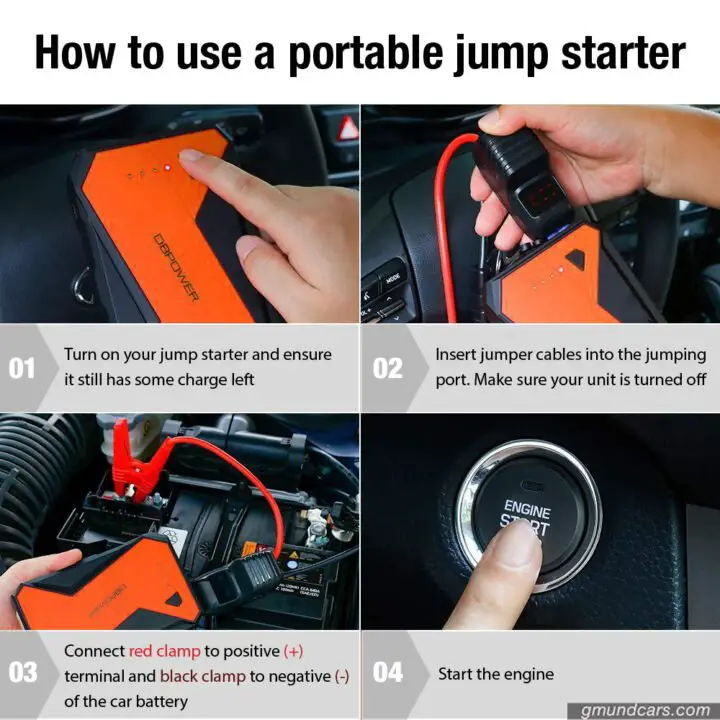
Step 1: First, confirm your portable jump starter is fully charged. You can test the unit’s stored energy capacity by switching the device on and seeing its power level. It is best to always use a fully charged portable jump starter.
Step 2: For your safety and to prevent damage to your car’s battery and your portable jump starter, make sure you turned off your vehicle’s ignition, and it is in “Park” (or, in the case of manual transmission vehicles, in neutral). When your engine kicks into life, you don’t want it to jerk forward and potentially knock you over.
Step 3: Before you go anywhere near the engine with your portable jump starter, ensure that your unit is turned off. It is easy to check: if there are any lights illuminated on the device, it usually means the power is on. Connecting a live portable jump starter to a car’s battery will create a series of sparks that could cause the battery to explode or your vehicle to catch fire. Make sure to also avoid the portable jump starter’s cables from touching each other or any other metal parts in your vehicle’s engine bay.
Step 4: Jumpstarting the car requires you to connect the portable jump starter to the car’s battery. A car battery comprises two terminals – a positive and a negative – accessible by their respective clamps. The portable jump starter can transfer its stored power to the car’s battery. Connecting the portable jump starter to the car’s battery is a straightforward process. The first of this process’s two steps is to locate the car battery’s positive and negative terminals. The positive terminal is indicated with a “+“, “P“, or “POS” sign and a red clamp cover. The negative terminal is indicated by a “–“, “N“, or “NEG” and a black clamp cover. These positive and negative terminals are on opposite ends of the battery to avoid any accidental cross-contact.
Step 5: However, it won’t be a case of merely clamping the portable jump starter’s cables to the car battery. You’ll need to do this in a sequence: First, the positive clamp to the positive battery terminal. Then you can connect the negative cable and negative terminal. If you were to attach the clamps in the wrong sequence, the portable jump starter would not charge the battery, and you might even cause the jump starter severe damage.
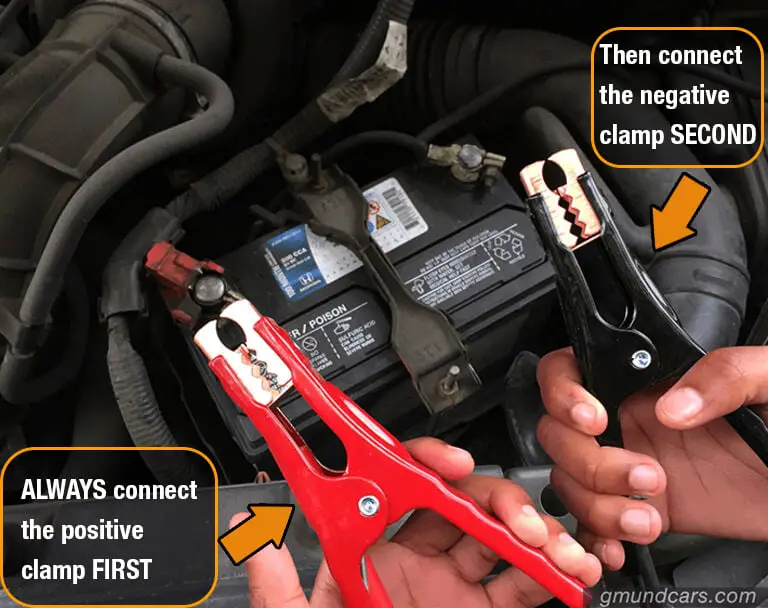
Step 6: Connecting the portable jump starter’s cables to the car’s battery terminals is an effortless process of matching the portable jump starter’s red and black cables to the car battery’s corresponding terminals for positive (red) and negative (black). There is, however, a catch to connecting jumper cables to older cars: some older vehicles don’t offer you access to the negative terminal. In those cases, you can attach the portable jump starter’s negative cable to any non-moving metal parts such as the engine block or the car’s chassis/frame.
Step 7: Once you’ve correctly connected the jump starter to the battery’s terminals, you can safely switch on the portable jump starter. You should see a light on the jump starter flick on to indicate that its power is now live.
Step 8: From under the car’s bonnet, move to the driver’s seat, but don’t immediately turn on the ignition. Allow the portable jump starter about 30 seconds to charge the car’s battery. Then, hit the start button or turn the key in the ignition slot to crank over the car’s engine. The engine should take on the first flick of the ignition.
Step 9: If the engine doesn’t crank over on the first attempt, wait 10-20 seconds before turning the ignition again. That will give the battery time to charge up even more for you to try to start the engine. Depending on how flat your car’s battery was, you might even need to take a third attempt.
Step 10: Once the car’s engine is running, leave the motor to idle for a few minutes while you feather the accelerator pedal. This will help increase its revs to above 1,500 rpm to help the engine charge the car’s battery faster.
Step 11: After those few minutes have passed, you can climb out of your car and make your way to the engine bay again.
Step 12: Before you do anything at the car’s battery again, be sure to turn off the portable jump starter. After that, you need to disconnect the portable jump starter’s cables in the following sequence: first, unclip the negative cable from the negative terminal and then do the same for the positive cable and terminal.
Step 13: Close your vehicle’s hood and allow the car to continue to idle for another minute or two. It is recommended that you take your vehicle for a short 10-15-minute drive around your neighborhood so that the engine can fully charge up the car’s battery.
Step 14: Once you’ve returned from your drive, remember to recharge your portable jump starter to be ready to work again when your car’s battery unexpectedly dies.
Read more: Why Does My Car Engine Knock On Startup Then Goes Away?
How to bypass the starter solenoid with a screwdriver
If your car won’t start, and you’ve eliminated a bad battery as the cause of this starting problem, you can still get the engine to crank over. For that, you’ll need to bypass the starter solenoid to jumpstart the car’s engine. Without getting too technical, a starter solenoid sends electrical current from the car’s battery to the starter motor. The starter motor, in turn, cranks over the car’s engine.
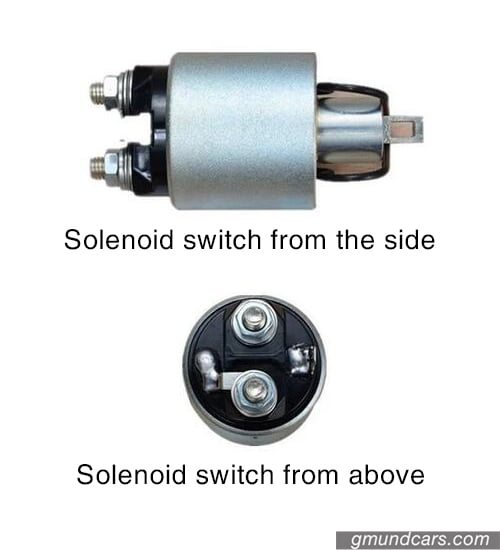
So how do you bypass such a critical aspect of this process? Simply put, by using a screwdriver, you’ll bring the car’s engine barking back into life.
Step 1: The first task is to locate your car’s starter solenoid. It mostly positions on top of your car’s starter motor. On older vehicles, the solenoid is located right next to the car’s battery. If you’re not sure what to look for under the hood, you can pinpoint the starter solenoid by tracing the electrical cabling from the positive terminal of the car’s battery. When looking at the battery’s positive terminal, you will see a red cable attached to the terminal. It is the cable that leads directly to the starter solenoid.
Step 2: For your safety, ensure your vehicle’s transmission is in “Park” or “N” (and in neutral, for those with manual transmissions).
Step 3: As you’ll be jumping the starter with a screwdriver, you’ll need the help of an assistant to complete the job. The other person will only be required only to turn the ignition in the car to crank over its engine on your instruction – and not earlier.
Step 4: The screwdriver you use for this job must have an insulated rubber handle. That protected handle will prevent you from being shocked by the electrical current that passes through the screwdriver’s shank.
Step 5: The starter solenoid has two posts on it. One post carries the positive (red) cable from the car’s battery. The other post connects directly to the starter motor (the larger component attached to the starter solenoid) via the negative (black) cable. What you need to do is bypass the starter solenoid with the screwdriver to crank the engine over.

Step 6: Place the screwdriver’s tip on the positive post. Then slide the screwdriver’s shank until it touches the other post that connects with the starter motor.
Step 7: Now, ask your friend or family member to turn the ignition to start the car’s engine. This will create a loud series of small electrical sparks. Make sure your skin doesn’t touch any metal parts of the screwdriver or the engine’s block when the engine is being cranked over, or you will be shocked by the electrical current.
Step 8: As soon as the engine cranks over, immediately remove the screwdriver from the starter solenoid.
What to do when your car alternator has failed
The good news: it is possible to start your car’s engine despite a bad alternator. For this, you’ll need a second car or truck with a good battery to jumpstart your car’s engine.
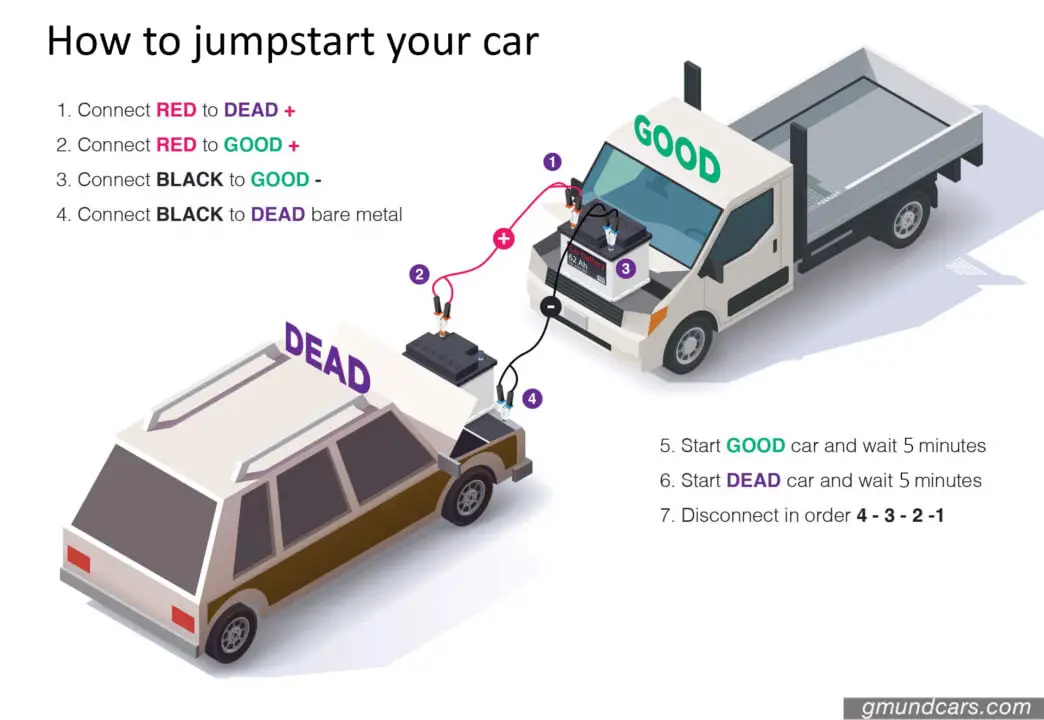
But the bad news is: once your vehicle is up and running, you need to head to your nearest auto shop to repair or replace your car’s alternator. Unfortunately, this isn’t a problem you can ignore.
Step 1: To jumpstart your car with a bad alternator, you’ll need a car or truck with a battery in good condition. This is because your battery will be drawing a lot of energy from the other car’s battery – and putting a strain on that other car’s battery. Don’t worry: it won’t damage the other car’s battery.
Step 2: Connect your car’s battery to the second car’s battery with a set of jumper cables. Ensure your car’s positive terminal is connected to the other car’s battery’s positive terminal, and the same goes with the negative terminals. The jumper cables’ red clamp must be attached to the red terminal and black clamp with the black terminal.
Step 3: Once connected, allow the second car’s engine to idle for about 5 minutes or so. Don’t attempt to start your vehicle this time and keep its ignition completely off. Make sure you don’t leave anything on in your car either, like headlights, A/C, or the radio. This will allow your car’s dead battery to absorb as much energy as possible from the other vehicle.
Step 4: After those 5 minutes, turn your car’s ignition to start your engine. Don’t turn the ignition and immediately release the key as you would normally when your car’s engine cranks over. Instead, hold the ignition for 2-3 seconds longer to see if the engine will crank over.
Step 5: If the engine doesn’t start after two such attempts, wait another 3 minutes and make sure you’ve completely turned your car off. Then, repeat steps 2, 3, and 4.
Step 6: Once your car’s engine has cranked over, disconnect the jumper cables by removing the red cables (positive) first and then the black cables (negative) from their respective terminals.
NOTE: It is recommended that you drive to your nearest auto repair shop to have your car’s alternator repaired or replaced to avoid any further such starting problems from damaging your car’s starter and battery.
Conclusion
We all have been stranded with our vehicles at one point in our life, and we probably will be again. Don’t think of this as a problem; think of it as an opportunity to make your car or truck more reliable and dependable by rooting out the bad and failing components. Regular maintenance on a vehicle is integral to its durability.

Diagnosing a problem with your car or truck’s starting system isn’t as complicated or troublesome as you might expect. Again, there are three main problems:
- Bad battery
- Defective starter motor
- Faulty alternator.
In conclusion, you can detect the cause of the starting problems through a process of elimination. Once you’ve identified the issues, you can easily replace a bad battery, a bad starter, or a bad alternator to return your vehicle to active duty once more.
FAQs
1. Can a completely dead battery be recharged?
Yes. But your car’s alternator isn’t designed to completely recharge a car’s battery if it’s been depleted before. It is recommended that you drive your vehicle for 10-15 minutes to allow the battery to recharge itself completely. If you have a trickle charger at home, attach that to safely recharge your car’s battery overnight.
Read more: How to recharge a completely dead battery »
2. What happens if I incorrectly connect the jumper cables to my car battery?
This will cause severe damage to your car’s electrical components such as on-board computers and electronic sensors.
3. Can I stop my battery from causing sparks?
Yes. You can ensure this won’t happen by completely turning off the car’s ignition and all its electrical accessories such as radio and headlights.